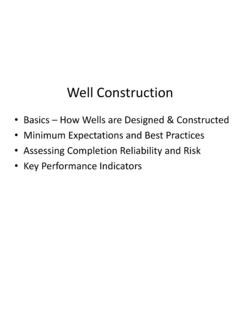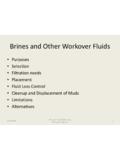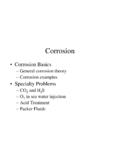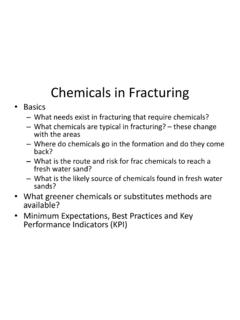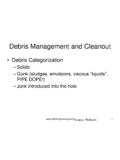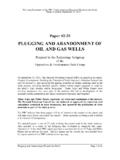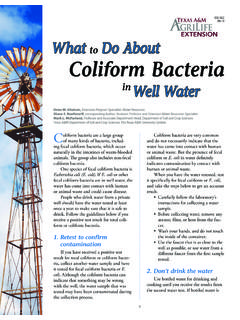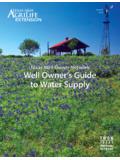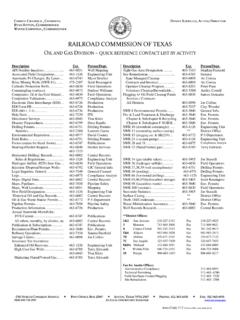Transcription of Slides for very basic education only! - …
1 Plug and Abandonment Producing well . Slides for very basic education only ! Different from drilling P&A operations. Specific regulations set by governing bodies. This presentation covers the intent of P&A: Isolate and protect all fresh and near fresh water zones;. Isolate and protect all commercial producing horizons for future development;. Prevent leaks from or into the well ;. Remove surface equipment and cut and plug pipe below ground level or fishing net level or, depending on requirements, mark the surface location so identification can be made at any time after abandonment. P&A responsibility does not usually end with the P&A. activities and not even with sale of the property . If it leaks, you will likely be held responsible for damage and to repair and remediate the well and the site. Do it right the first time. George E. King Engineering 3/14/2009 1. Abandonment Types: TA and P&A.
2 TA temporarily abandoned : During a long shut-down. Waiting on a workover. Waiting on field development or redevelopment. Opinion do not delay abandonments that need to be done. In many cases, delays have increased P&A cost by 1 to 2+ orders of magnitude. Set plugs to prevent cross flow and production. Isolate all flow and protect from pressures. Test and monitor the well and keep good records. George E. King Engineering 3/14/2009 2. Abandonment Types P&A plugged and abandoned : End of current economic operations. well problem that cannot be economically repaired. Moving the bottom hole location P&A the bottom and reuse the top part of the well . Set cement and mechanical plugs to prevent cross flow and production. Isolate all flow and protect from pressures. Follow governing body regulations. Opinion exceed the regulations and make sure it doesn't leak. Regulations change and companies might be held liable for further repairs even if the well was properly P&A'd under existing laws of the time.
3 George E. King Engineering 3/14/2009 3. P&A Costs On Shore: nothing to low expense. well equipment recovered often offsets cost of P&A. Off-Shore: $100k to millions. Depends on whether isolated wells or whole campaign to decommission a platform. Depends on depth, pressure and potential to endanger fishing, shipping, coast line, etc. Significantly increased by platform damage from storms, ship impact or corrosion. George E. King Engineering 3/14/2009 4. well damage increases the P&A cost sharply 100k to 10's of millions George E. King Engineering 3/14/2009 5. Pipe damage may necessitate pulling operations not in the original plans. Cement plugs generally need to be circulated into place a functional tubing string is required. Special Conditions and considerations: 1. Collapsed or burst pipe repairs are difficult because the tubing has to be fished, often in pieces. Burst sections have to be sealed and isolated.
4 Setting effective cement plugs is critical. 2. Channels and fractures in annulus cement or shoe areas. Setting long cement plugs requires effective sealing of fractures. George E. King Engineering 3/14/2009 6. Legislative Drivers Safe water Drinking Acts Numbers of abandoned wells both hydrocarbon and water (>3mm in US since 1859) and reliability of the abandonment seals. Changing government regulations on fresh and near fresh waters. Protection of resources for the future (fields are often abandoned with 60 to 80% of oil and 10 to 20%. of the gas still in place) waiting on technology development often for decades. George E. King Engineering 3/14/2009 7. Main targets that must be sealed Isolation: open hole, separate pay zones, perforations, liner tops and channels in cement, surface locations (3' or 1m on land to 10 to 15' or 3 to 5m, below ML offshore). damaged sections (wear points, milling, perfs, etc.)
5 , multi-laterals, corrosive zones (highly corrosive salt water ?) , special cases (clearing sea floor, rigs to reefs, geothermal, etc.). George E. King Engineering 3/14/2009 8. Requirements Plug thickness (height). Tag to validate plug position. Pressure tests to validate seal. well Identification(?). Marking of lost radioactive source tools. George E. King Engineering 3/14/2009 9. Threats From Improperly abandoned Wells Contaminated surface water entry (minerals, bacteria, waste, etc.). Surface leakage from shallow zones through well or leaking cement sheath. Leakage form an aquifer to surface. Leakage from surface to an aquifer. Danger of open well to surface egress (falling down the well ). George E. King Engineering 3/14/2009 10. Materials Used in Abandonment Cement slurries. Gelled pills (bentonite and others). Spacers to protect cement slurries. Mechanical plugs (incl. cement retainers).
6 Inflatable plugs. Sand plugs (as base for cement). George E. King Engineering 3/14/2009 11. P & A Concerns Knowledge of the well where are plugs needed? Perforations Wear areas in the casing Multilateral junctions Overlap seal stability Channels and fractures in cement sheath Fracturing far out of zone (probably rare?). Etc. Placement accuracy and seal reliability of plugs. Reliability of the cement sheath. Reliability of the overall P&A system. George E. King Engineering 3/14/2009 12. Cement Plugs Cement slurry design. Cement type and additives. API class Extenders, shrinkage, gas control, fluid loss control, formation and pipe adherence, spacers. Volumes and excesses. Placement method. Location identification, Depth control, Spotting method (bailer, circulation, etc.), Contamination control, Testing requirements. George E. King Engineering 3/14/2009 13. Cement Plug Placement Balanced method.
7 Modified balanced method. Displacement from surface. Two plug circulation. Grouting various. Mechanical assistance. George E. King Engineering 3/14/2009 14. Setting a cement plug Not as easy as it may seem Position of the end of tubing (EOT) may not correspond to where the plug is actually set. What are the considerations of setting a cement plug in mud? Effect of fluid loss and cross flow on setting an effective cement plug? George E. King Engineering 3/14/2009 15. Setting Cement Plugs A near 100% reliable system if cross flow can be stopped. Most cement plugs fail because of cross flow, density and viscosity mismatch, or failure to break the fluid momentum. Full plug method described and field tested in SPE 11415 (published in SPE JPT Nov 1984, pp 1897-1904) and SPE 7589. George E. King Engineering 3/14/2009 16. Cement Plug Failure Many cement plugs fail for the same 4 reasons: 1.
8 Cross flow cuts channels into the plug. 2. Cement is higher density that the mud cement falls through the mud. Mud contamination of the cement may keep it from setting. 3. The mud is much lower viscosity than the cement slurry cement falls through the mud 4. The open ended tubing produces a high momentum energy condition that the mud cannot stop thus cement falls through the mud. The result of the last three is that the cement is spread out along the hole and a plug is never formed. George E. King Engineering 3/14/2009 17. How? 1. Use a simple tubing end plug with circulation to the side and upward but not downward. 2. Spot a heavily gelled bentonite pill below the cement plug depth. Pill thickness of 500- 800 ft (152- 244 m). 3. Use a custom spacer to separate the pill and the cement slurry. 4. Use a viscous, thixotropic cement with setting time equal to the job time plus hr.
9 Plug thickness of 300 to 600 ft (91 to 183 m). 5. Rotate the centralized tubing (do not reciprocate) during placement and gently withdraw at the end of the pumping. 6. WOC = 4 hrs for every 1 hour of pump time. Full details and field tests in SPE 11415. George E. King Engineering 3/14/2009 18. Diverter Plug on End of Tubing A simplified diverter tool can be made by plugging the end of tubing and drilling 8 holes the bottom four straight out and the top four angled up at 45o. Holes are to 1 (2 to cm) diameter. George E. King Engineering 3/14/2009 19. Laying Sand Plugs Shut-in well for several hours to prevent crossflow disruption of plug. Don't bury the BHA with dumped sand Tag frequently to avoid over-fill Use a gel spacer in front of sand to prevent sand roping or falling down the hole. Rapid sand fall out can cause bridge off inside the CT. Sand plugs are often used as a base for more stable plugs.
10 George E. King Engineering 3/14/2009 20. Sand fall rates in various fluids 10/20 mesh sand 20/40 mesh sand Fluid ft/min m/min ft/min m/min WF220 WF240 WF260 Diesel water 10/20 mesh Bauxite 20/40 mesh Bauxite Fluid ft/min m/min ft/min m/min WF220 WF240 1 WF260 1 Diesel water George King Engineering 20 3/14/2009 21. Source D/S Field Book Reasons for Cement Plug Failures Contamination of the cement slurry with drilling mud during or immediately after placement. Failure to place a viscous pill to stop downward movement of cement slurry. Inaccurate knowledge of volumes required. George E. King Engineering 3/14/2009 22. General Requirements Onshore 10 ft (3 m) plug on top of the well and casing cut 3 ft (1m) below the ground surface. Mud between plugs ( lb/gal). Plug thickness minimum of 100 ft, plus 10%. for each 1000 ft of zone. George E. King Engineering 3/14/2009 23. Procedures Remove salvageable equipment.
